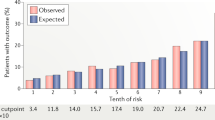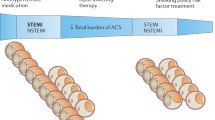Abstract
Cardiovascular disease including acute myocardial infarction and sudden death is the leading cause of death in the United States and worldwide. Important advances in prevention and therapy have been able to recently reduce their prevalence and improve therapeutic outcomes. However, much more work needs to be done. While standard risk factors can identify those most likely to succumb from these conditions, most of these events unfortunately occur in the low to intermediate risk populations.
This chapter considers the two main approaches for reducing subsequent events: (1) identifying and treating the vulnerable plaque versus (2) identification and treating the vulnerable or high risk patient. Which approach will be the most efficacious in reducing subsequent hard cardiovascular events.
Access this chapter
Tax calculation will be finalised at checkout
Purchases are for personal use only
Similar content being viewed by others
References
Go AS, Mozaffarian D, Roger VL, et al. Heart disease and stroke statistics – 2014 update: a report from the American Heart Association. Circulation. 2014;129(3):e28–292.
Vasas RS, Sullivan LM, Wilson PWF, et al. Relative importance of borderline and elevated levels of coronary heart disease risk factors. Ann Intern Med. 2005;142(6):393–402.
Bentzon JF, Otsuka R, Virmani R, Falk E. Mechanisms of plaque formation and rupture. Circ Res. 2014;114(12):1852–66.
Fujii K, Mintz GS, Carlier SG, Costa Jr JD, et al. Intravascular ultrasound profile analysis of ruptured coronary plaques. Am J Cardiol. 2006;98:429–35.
Ambrose JA, Tannenbaum MA, Alexopoulos D, et al. Angiographic progression of coronary artery disease and the development of myocardial infarction. J Am Coll Cardiol. 1988;12:56–62.
Litttle WC, Constantinescu M, Applegate RJ, et al. Can coronary angiography predict the site of a subsequent myocardial infarction in patients with mild to moderate coronary artery disease? Circulation. 1988;78:1157–66.
Yamagishi M, Terashima M, Awano K, et al. Morphology of vulnerable coronary plaque: insights from follow-up of patients examined by intravascular ultrasound before an acute coronary syndrome. J Am Coll Cardiol. 2000;35:106–11.
Giroud D, Li JM, Urban P, Meier B, Rutishauser W. Relation of the site of acute myocardial infarction to the most severe coronary arterial stenosis at prior angiography. Am J Cardiol. 1992;69:729–32.
Ambrose JA. In search of the “vulnerable plaque”: can it be localzied and will focal regional therapy ever be an option for cardiac prevention? J Am Coll Cardiol. 2008;51(16):1539–42.
Stone GW, Maehara A, Lansky AJ, et al. A prospective natural-history study of coronary atherosclerosis. N Engl J Med. 2011;364:226–35.
Kubo T, Imanishi T, Takarada S, et al. Assessment of culprit lesion morphology in acute myocardial infarction. Ability of ocular coherence tomography compared with intravascular ultrasound and coronary angioscopy. J Am Coll Cardiol. 2007;50:933–9.
Jia H, Abtahian F, Aguirre AD, Lee S, et al. In vivo diagnosis of plaque erosion and calcified nodule in patients with acute coronary syndrome by intravascular optical coherence tomography. J Am Coll Cardiol. 2013;62(19):1748–58.
Virmani R, Burke AP, Farb A, Kolodgie FD. Pathology of the vulnerable plaque. J Am Coll Cardiol. 2006;47:C13–8.
Lerner DJ, Kannel WB. Patterns of coronary heart disease morbidity and mortality in the sexes: a 26 year follow-up of the Framingham population. Am Heart J. 1986;111:383–90.
Zipes DP, Wellens HJJ. Sudden cardiac death. Circulation. 1998;98:2334–51.
Stone NJ, Robinson J, Lichtenstein AH, et al. 2013 ACC/AHA guidelines on the treatment of blood cholesterol to reduce atherosclerotic cardiovascular risk in adults: a report of the American College of Cardiology/American Heart Association Task Force on Practice Guidelines. Circulation. 2014;129(25 Suppl 2):S1–45.
Falk F, Sillesen H, Fuster V. The high-risk plaque initiative: primary prevention of atherothrombotic events in the asymptomatic population. Curr Atheroscler Rep. 2011;13:359–66.
Fernández-Ortiz A, Jiménez-Borrequero LJ, Peńalvo JL, et al. The progression and early detection of subclinical atherosclerosis (PESA) study: rational and design. Am Heart J. 2013;166(6):990–8.
Ridker PM, Rifai N, Rose L, Burning JE, Cook NR. Comparison of C-reactive protein and low-density lipoprotein cholesterol levels in the prediction of first cardiovascular events. N Engl J Med. 2002;347:1557–65.
Ridker PM, Danielson E, Fonseca FAH, et al. Rosuvastatin to prevent vascular events in men and women with elevated c-reactive protein. N Engl J Med. 2008;359:2195–207.
Cheng JM, Akkerhuis KM, Meilhac O, et al. Circulating osteoglycin and NGAL/MMP9 complex concentrations predict 1-year major adverse cardiovascular events after coronary angiography. Arterioscler Thromb Vasc Biol. 2014;34:1078–84.
Liu CF, Qin L, Ren JY, Chen H, Wang WM, Liu J, Song JX, Li LJ. Elevated plasma lipoprotein-associated phospholipase A2 activity is associated with plaque rupture in patients with coronary artery disease. Chin Med J. 2011;124(16):2469–73.
Goff DC, Loyd-Jones DM, Bennett G, Coady MS, et al. 2013 ACC/AHA guideline on the assessment of cardiolovascular risk. Circulation. 2014;129:S49–73.
Clinical trials.gov. Cardiovascular Inflammation Reduction Trial (CIRT). www.clinicaltrials.gov/show/NCT0159433.
Catellano JM, Sanz G, Fernandez OA, Garrido E, Bansilal S, Fuster V. A polypill strategy to improve global secondary cardiovascular prevention: from concept to reality. J Am Coll Cardiol. 2014;64:613–21.
The Indian Polycaps Study (TIPS) Investigators. Effects of a polypill (Polycap) on risk factors in middle-aged individuals without cardiovascular disease (TIPS): a phase II, double-blind randomized trial. Lancet. 2009;373:1341–3151.
Rodgers A, Patel A, Berwanger O, et al.; The PILL Collaborative Group. An international randomized placebo-controlled trial of a four-component combination pill (“polypill”) in people with raised cardiovascular risk. PLoS One. 2011;6(5):e19857.
Wald DS, Morris JK, Wald NJ. Randomized Polypill crossover trial in people aged 50 and over. PLoS One. 2012;7, e41297.
Malekzadeh F, Marshall T, Pourshams A, et al. A pilot double-blind randomised placebo-controlled trial of the effects of fixed-dose combination therapy (‘polypill’) on cardiovascular risk factors. Int J Clin Pract. 2010;64:1220–7.
Akhter N, Milford-Beland S, Roe MT, Piana RN, Kao J, Shroff A. Gender difference among patients with acute coronary syndromes undergoing percutaneous coronary intervention in the American College of Cardiology-National Cardiovascular Data Registry (ACC-NCDR). Am Heart J. 2009;157:141–8.
Centers for Disease Control and Prevention (CDC). Smoking-attributable mortality, years of potential life lost, and productivity losses: United States, 2000–2004. MMWR Morb Mortal Wkly Rep. 2008;57:1226–8.
Mackay DF, Irfan MO, Haw S, Pell JP. Meta-analysis of the effect of comprehensive smoke-free legislation on acute coronary events. Heart. 2010;96:1525–30.
Ambrose JA, Acharya T. Reducing acute coronary events- the solution is not so difficult. Am J Med. 2015;128:105–6.
Lloyd-Jones DM, Leip EP, Larson MG, et al. Prediction of lifetime risk for cardiovascular disease by risk factor burden at 50 years of age. Circulation. 2006;113:791–8.
Author information
Authors and Affiliations
Corresponding author
Editor information
Editors and Affiliations
Rights and permissions
Copyright information
© 2015 Springer International Publishing Switzerland
About this chapter
Cite this chapter
Kiel, R.G., Ambrose, J.A. (2015). Vulnerable Plaques Versus Patients-How to Reduce Acute Coronary Events in the Future. In: Ambrose, J., Rodríguez, A. (eds) Controversies in Cardiology. Springer, Cham. https://doi.org/10.1007/978-3-319-20415-4_3
Download citation
DOI: https://doi.org/10.1007/978-3-319-20415-4_3
Publisher Name: Springer, Cham
Print ISBN: 978-3-319-20414-7
Online ISBN: 978-3-319-20415-4
eBook Packages: MedicineMedicine (R0)




